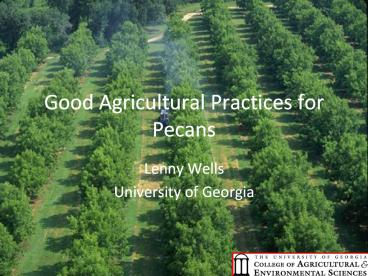Good Agricultural Practices for Pecans PowerPoint PPT Presentation
1 / 23
Title: Good Agricultural Practices for Pecans
1
Good Agricultural Practices for Pecans
- Lenny Wells
- University of Georgia
2
Good Agricultural Practices (GAPs) Reduce Risks
of Microbial Contamination
- GAPs Topics
- Water
- Manure and Municipal Biosolids
- Worker Health and Hygiene
- Sanitary Facilities
- Field Sanitation
- Shelling/Cleaning Facilities
- Transportation
- Traceback
3
Why Should We Care?
- Every year microbial contamination results in an
estimated - 76 million cases of foodborne illness.
- 325,000 people hospitalized for foodborne
illness. - 5,200 needless deaths each year.
- Economic losses between 10-83 billion dollars.
4
How many outbreaks have been linked to Nuts?
Adapted from Danyluk et al., 2007
5
Intrinsic Safety of Pecans - Beliefs
- The thick shells of some nuts are thought to be
an effective barrier to microbial penetration - The presence of a hull or husk is thought to
further reduce the risk of microbial invasion. - The internal surface of a dry intact kernel
picked from the tree is virtually sterile
(Chipley and Heaton, 1971 Meyer and Vaghun, 1969)
6
Intrinsic Safety of Pecans - Reality
- Hull or shell splitting can occur on the prior to
or after harvest - Different varieties have widely differing shell
thicknesses - Birds, other vertebrates or insects may also
damage the shell - Shells may crack along the suture during wetting
or drying. - Pecan nut packing tissue is toxic to salmonella,
affording some protection to initial
contamination and survival (Beuchat and Heaton,
1974).
7
Pecan Outbreaks
- July 2009
- General Mills announces recall of certain lots of
Nature Valley Granola Nut Clusters, due to the
possibility that pecans used in the Nut Clusters
might be "... tainted with Salmonella."
8
So what can be done?
- Prevention
- Try to avoid contaminatingthe product in the
firstplace. - Once food becomes contaminated, its almost
impossible to clean completely.
9
GAPs - Water
- This consideration should include water used for
irrigation, mixing pesticides and other
foliar-applied products, equipment sanitation,
product sanitation, and cooling operations. - The operator should be aware of the source,
distribution, and quality of all water utilized.
10
Water Carries Pathogens
- E. coli O157H7 viewed primarily as a water-borne
pathogen. - Salmonella, Giardia and Cyclospora outbreaks on
produce caused by contaminated water.
11
Spray Water Quality
- Use potable (drinking) water for pesticide
sprays. - When potable water is not available, test water
quality and keep records.
12
GAPs Manure and Municipal Biosolids
- Properly treated manure or biosolids can be an
effective and safe fertilizer if the proper
precautions are in place. - Use treatments to reduce pathogens in manure and
other organic materials. Treatments may be active
(e.g., composting) or passive (e.g., aging).
13
GAPs Manure and Municipal Biosolids
- Be aware that sitting manure treatment and
storage sites close to orchards increases the
risk of contamination. - Consider factors such as slope and rainfall and
the likelihood of runoff into orchard - Use barriers or physical containment to secure
storage and treatment sites. - Do not apply manure to the
orchard lt180 days prior to harvest
14
Exclude Animals
- Manage rodents and birds in cleaning plants and
storage areas. - No dogs or other pets in the orchards.
- Keep wildlife out of production areas as much as
possible.
15
Salmonella and nut production
- Grazing domestic animals is practiced in some
regions - E. coli levels on pecans increased from 4 to
23 following grazing - Contamination on pecans increased to 36, with
grazing in a wetproduction year (Marcus and
Amling, 1973)
Courtesy of Dr. M. Danyluk
16
GAPs Worker Health and Hygiene
- Train employees to follow good hygiene practices.
- Establish a training program about health and
hygiene. Include basics, such as proper
handwashing techniques and the importance of
using toilet facilities. - Become familiar with typical signs and symptoms
of infectious diseases. - Offer protection to workers with cuts or lesions
17
GAPs Sanitary Facilities
- Toilet facilities should be properly located.
- Toilet facilities should be accessible
and clean. - Toilet facilities and handwashingstations should
be well-supplied.
18
GAPs Field Sanitation
- Clean harvest containers or bins prior to use.
- Use harvesting equipment appropriately and keep
it as clean as practicable.
19
GAPs Cleaning Plants/Shelling Facilities
- Proper sorting and culling.
- Enforce Good Worker Hygiene.
- Exclude all animals from facility, especially
insects, birds and rodents. - Clean and Sanitize Equipment.
- Detectable Free Chlorine in Wash Waters.
20
GAPs - Transportation
- Good hygienic and sanitation practices should be
used when loading, unloading, and inspecting
pecans. - Inspect transportation vehicles for cleanliness,
odors, and obvious dirt and debris before
loading. - Avoid leaving harvested crop in the sun and
maintain proper temperatures throughout the
transportation process. - Load pecans to minimize cracking.
21
GAPs - Traceback
- Documentation should include the source of the
product, the date of harvest, farm
identification, and a record of who handled the
product. - The product must be traceable from the farm
through the accumulator, sheller,distributor,
transporter, and retailer.
22
If you did not RECORD IT,you did not do it.
- Record keeping allows you to keep track of
farming and packing operations and worker
training. - Record keeping documents youractivities should
this informationever be required.
23
Be Active and Be Ready
- Make changes to management practices as needed.
- Keep good records of all production practices.
- Teach employees the importance of prevention
strategies and provide proper facilities. - Work with upstream neighbors and local watershed
committees on management goals. - Update your plan regularly.

